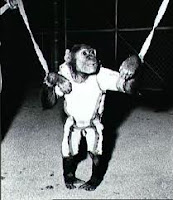Posted
on November 30, 2013
Alabama
resident Ann Hodges was just minding her own business, taking an
afternoon nap, on this date in 1954.
When
suddenly – CRASH! – a meteorite bulleted through her roof,
bounced off of a radio (thank goodness, this was in the days when
radios were large pieces of wooden furniture!), and hit her as she
lay on the couch.
She
was badly bruised where the meteorite hit her—but she was basically
fine, and of course the bruise healed.
 The
meteor was so bright in the sky, as it burned through the atmosphere,
that people in three different states saw it as a fireball in the sky
even though it was daytime! Some witnesses reported hearing an
explosion or boom, which was probably an air blast or shock wave
created by the chunk of space rock pushing through the air at such a
tremendous speed.
The
meteor was so bright in the sky, as it burned through the atmosphere,
that people in three different states saw it as a fireball in the sky
even though it was daytime! Some witnesses reported hearing an
explosion or boom, which was probably an air blast or shock wave
created by the chunk of space rock pushing through the air at such a
tremendous speed.
(By
the way, did you notice that a chunk of space rock is called a meteor
when it is streaking through the atmosphere? The chunks that are
large enough to reach the ground (most burn all the way up in the
atmosphere) are called meteorites once they make impact. And
when they are still floating around in space, they are sometimes
called meteoroids!)
 The
U.S. Air Force sent out a helicopter to take the meteorite from
Hodges. (I guess they were worried it might be a piece of some sort of
Soviet technology.)
The
U.S. Air Force sent out a helicopter to take the meteorite from
Hodges. (I guess they were worried it might be a piece of some sort of
Soviet technology.)
Hodges and her husband were briefly famous—and offers to buy the meteorite poured in from all over—so they hired a lawyer to
get it back from the government. The owner of the house that the
Hodges rented felt that she should be able to own the
meteorite, and sell it to cover the cost of the repairs. Finally, a
year after the meteorite impact, the government awarded ownership to
Ann Hodges.
By
that time, however, people were “over” the excitement, and Hodges
couldn't find a buyer. So she donated it to the local university's museum of natural history.
It's
pretty cool because the meteorite is commonly called the Hodges
meteorite!
By
the way...
I
mentioned in my title that Hodges was the only human to be documented
to have been hit by a meteorite. However, there is a written but
unconfirmed report that a man in what is now Italy died after being
hit by a meteorite in 1677, and in 1992 a really tiny fragment of a
meteorite hit a boy in Uganda—after being slowed down by a tree. So
I am not entirely sure why the Hodges meteorite is called “the only
documented case of a meteorite hitting a human”!
Also
on this date:
Plan
Ahead:
Here
are my Pinterest boards for:













































.jpg)